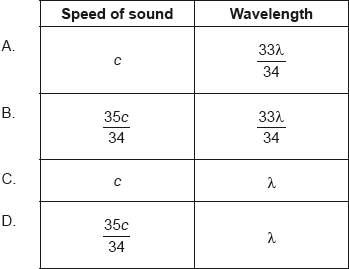| Date | May 2022 | Marks available | 4 | Reference code | 22M.2.HL.TZ2.6 |
| Level | Higher level | Paper | Paper 2 | Time zone | 2 |
| Command term | Determine | Question number | 6 | Adapted from | N/A |
Question
An experiment to investigate simple harmonic motion consists of a mass oscillating at the end of a vertical spring.
The mass oscillates vertically above a motion sensor that measures the speed of the mass. Test 1 is carried out with a 1.0 kg mass and spring of spring constant . Test 2 is a repeat of the experiment with a 4.0 kg mass and spring of spring constant .
The variation with time of the vertical speed of the masses, for one cycle of the oscillation, is shown for each test.
Calculate the frequency of the oscillation for both tests.
Deduce .
Determine the amplitude of oscillation for test 1.
In test 2, the maximum elastic potential energy Ep stored in the spring is 44 J.
When t = 0 the value of Ep for test 2 is zero.
Sketch, on the axes, the variation with time of Ep for test 2.
The motion sensor operates by detecting the sound waves reflected from the base of the mass. The sensor compares the frequency detected with the frequency emitted when the signal returns.
The sound frequency emitted by the sensor is 35 kHz. The speed of sound is 340 m s−1.
Determine the maximum frequency change detected by the sensor for test 2.
Markscheme
1.3 «Hz» ✓
OR ✓
0.25 OR ✓
vmax = 4.8 «m s−1» ✓
«» = 0.61 «m» ✓
Allow a range of 4.7 to 4.9 for MP1
Allow a range of 0.58 to 0.62 for MP2
Allow ECF from (a)(i)
Allow ECF from MP1.
all energy shown positive ✓
curve starting and finishing at E = 0 with two peaks with at least one at 44 J
OR
curve starting and finishing at E = 0 with one peak at 44 J ✓
Do not accept straight lines or discontinuous curves for MP2
read off of 9.4 «m s−1» ✓
use of OR ✓
f = 36 «kHz» OR 34 «kHz» ✓
«recognition that there are two shifts so» change in f = 2 «kHz» OR f = 37 «kHz» OR 33 «kHz» ✓
Allow a range of 9.3 to 9.5 for MP1
Allow ECF from MP1.
MP4 can also be found by applying the Doppler effect twice.
Examiners report
ai) The majority managed to answer this question correctly.
aii) A very well answered question where most worked correctly from the formula for the period of oscillation of a spring.
aiii) Quite a few answers had vmax from the wrong test.
aiv) Most common answers were a correct 2 peak curve, a correct 1 peak curve and a sine curve. Several alternatives were included in the MS as the original data provided in the question was inconsistent, i.e. 44 J is not the maximum kinetic energy available for the second test, and that was taken into account not to disadvantage any candidate´s interpretation.
b) Many got the first three marks for a correct Doppler shift calculation from the correct speed. . There were very few good correct full answers, might be a question to look at for 6/7 during grading.


